This plant species has been classified as critically endangered and in need of conservation by the World Red List.
Bù Gia Mập National Park is renowned for its rich biodiversity. Currently, the park is home to 1,114 plant species belonging to 480 genera and 126 families across 5 divisions of vascular plants, among which there are 24 threatened, endangered, rare, and endemic species. Additionally, it hosts 832 animal species, including 106 mammals, 248 birds, 59 reptiles, 28 amphibians, 342 insects, and 49 fish species. Notably, 61 animal species are also classified as threatened, endangered, or rare. In terms of non-timber forest products, the park contains 345 species of plants valuable for medicinal purposes, many of which play significant roles in societal life. Particularly, the park is home to a completely new species for science, endemic to the area, known as Bù Gia Mập golden tea (Camellia bugiamapensis).
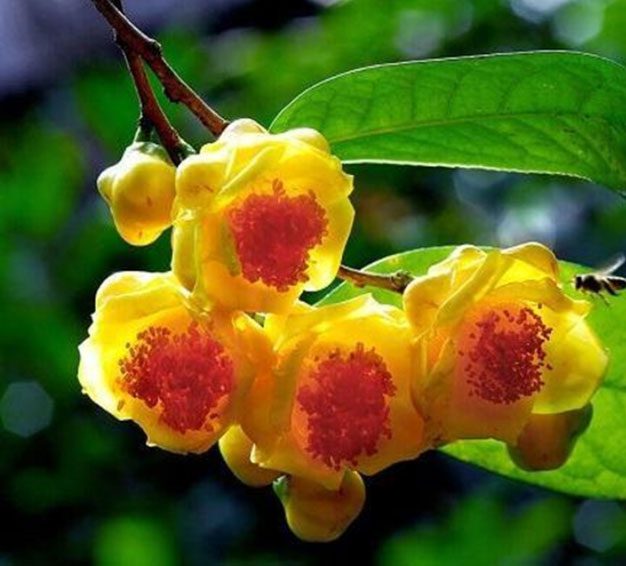
The rare plant at high risk of extinction is Bù Gia Mập golden tea. (Photo: Internet).
Where to Find This Rare Plant
The plant in question is Bù Gia Mập golden tea. According to Bình Phước Online, Bù Gia Mập golden tea is scientifically named Camellia bugiamapensis Orel, Curry, Luu & Q. D. Nguyen. This species is endemic to Bù Gia Mập National Park and was officially announced in 2014. It is known for its beautiful flowers, making it highly valuable for landscaping.
Bù Gia Mập golden tea is also referred to by other names such as golden camellia, longevity tea, and forest tea. The plant has a small, green, woody stem, typically reaching heights of 2 to 5 meters. Its branches are sparse, and the bark is light yellowish-gray.
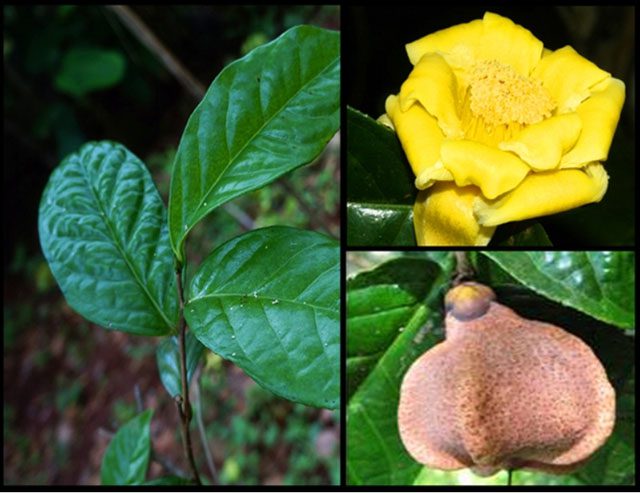
Bù Gia Mập golden tea is a rare plant in the tea family in Vietnam. (Photo: Internet).
The leaves are simple, alternate, elongated, and oval-shaped. Leaf blades measure approximately 11 to 14 cm in length and 4 to 5 cm in width, lacking hairs, with small serrations along the edges, featuring about 10 pairs of lateral veins, and a petiole length of 6-7 mm.
The flowers of Bù Gia Mập golden tea grow singly on leaf stalks, each flower consisting of 8-10 striking yellow petals. They have 3-4 fused stamens, and the flowers measure about 5-6 cm in diameter, showcasing diverse morphology.
The peak flowering period is from November to March, during which the plant also produces new leaves.
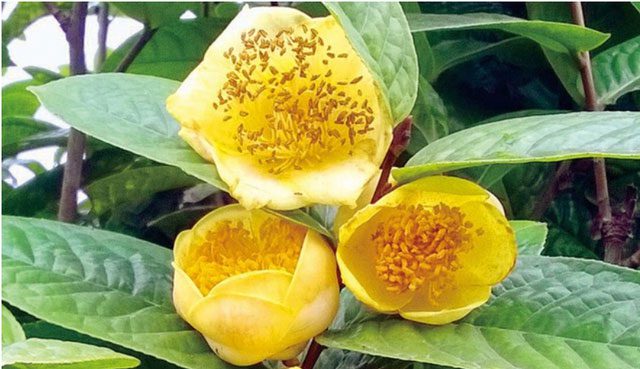
This plant is very special; it thrives only in mountainous areas and does not favor direct sunlight. (Photo: Internet).
This plant is unique as it thrives only in mountainous regions and does not prefer direct sunlight. Therefore, it develops best when grown under large trees in soil that mimics its natural environment.
According to the Bù Gia Mập National Park website, Bù Gia Mập golden tea is a rare plant in the tea family (Theaceae) in Vietnam. There are approximately 500 species of golden tea worldwide, classified into 18 different genera, with the Camellia genus containing around 100-250 species. In Vietnam, golden tea is cultivated and grows wild from North to South, with about 68 species recorded. Bù Gia Mập golden tea has garnered significant interest from both domestic and international scientists due to its unique habitat representing the transition climate zone from the highlands to the Southeast region, which is not found elsewhere.
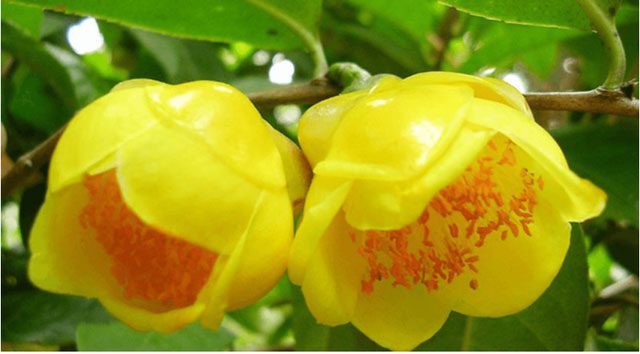
This type of golden tea is only found within a small range (1 km²) in Bù Gia Mập National Park. (Photo: Internet).
This golden tea species is only found within a small range (1 km²) in Bù Gia Mập National Park. Bù Gia Mập golden tea has been included in the IUCN Red List (2018). The number of mature trees is extremely low, estimated at around 49-70 trees, and it is classified as CR (Critically Endangered). Besides its genetic conservation value, scientists have also assessed that Bù Gia Mập golden tea possesses medicinal value similar to many globally recognized golden tea species.
A Medicinal Plant Highly Valued by Experts
According to Bình Phước Newspaper, among all golden tea types, Bù Gia Mập golden tea is considered to have high medicinal value. To date, numerous studies, both nationally and internationally, have focused on the medicinal properties of Bù Gia Mập golden tea. Analytical research results indicate the presence of over 400 recognized bioactive compounds. Bù Gia Mập golden tea contains many valuable compounds, such as saponins, polyphenols, polysaccharides, flavonoids, and elements like selenium (Se), germanium (Ge), potassium (K), zinc (Zn), molybdenum (Mo), vanadium (V), manganese (Mn), and vitamins B1, B2, C, etc. These substances are important for applications in cancer treatment, blood sugar regulation, liver detoxification, body cleansing, anti-aging, vitality enhancement, and stress reduction.
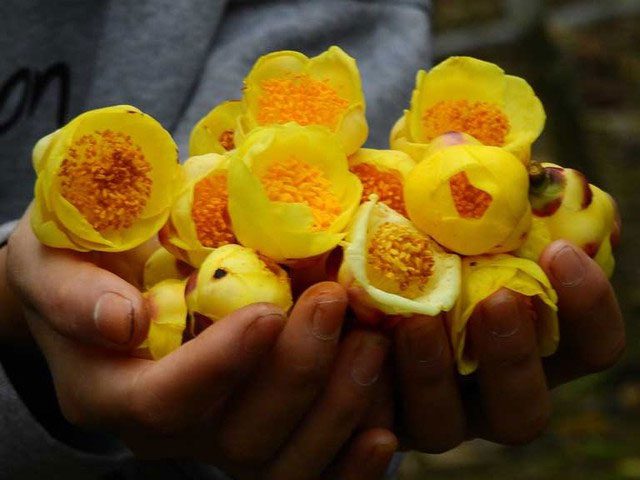
Bù Gia Mập golden tea contains many valuable compounds. (Photo: Internet).
According to traditional medicine, this precious tea is evaluated to have a light, delicate fragrance and a sweet taste with a neutral property. It is classified into the kidney, spleen, and heart meridians. Due to its properties, this medicinal herb is effective in preventing certain diseases, acting as a strong diuretic, and detoxifying the liver and kidneys. Not only does it help eliminate excess fluids, but this drink also effectively detoxifies and cleanses the body. Additionally, golden tea supports blood sugar reduction in diabetic patients, stabilizing blood sugar levels and reducing complications, helps cool the body, detoxify the liver, treat liver diseases, aid in weight loss, enhance immunity, alleviate common ailments like colds and runny noses, combat allergies and inflammation, and maintain stable blood pressure levels.
Scientists in many countries worldwide have researched and proven that the leaves, flowers, and buds of the tea plant can all be used for medicinal purposes. Among them, leaves and buds can be harvested at any time of the year, while tea flowers should be collected in March or April each year. This is when the flowers hold the most nutritional value for medicinal use.
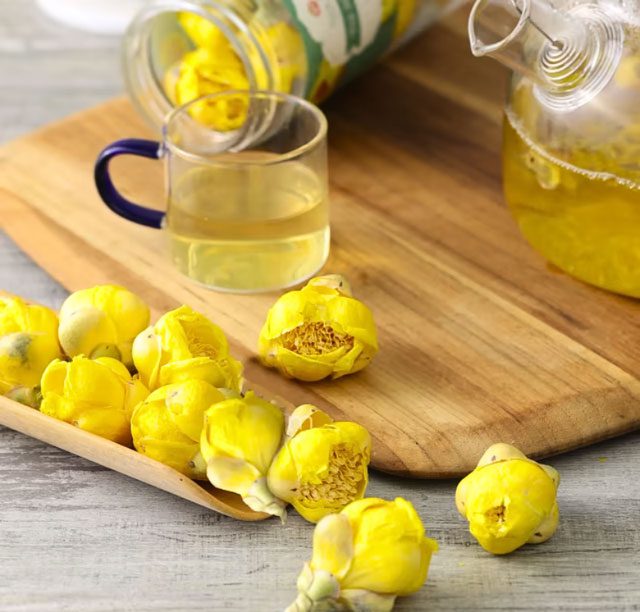
Bù Gia Mập golden tea is a rare plant that needs to be propagated and further developed. (Photo: Internet).
After harvesting, users can consume the medicinal materials fresh or dry them in the sun or through a drying process, then roast them to create dried golden tea for use. According to the experience of processing golden tea, to obtain 1 kg of dried golden tea, 10 kg of fresh flowers are required.
Thus, Bù Gia Mập golden tea is a rare plant with great potential in medicinal production that needs to be propagated and further developed. Effectively researching and conserving the golden tea species found in Bù Gia Mập National Park is an essential and necessary task to timely protect these valuable natural resources for future generations.


















































